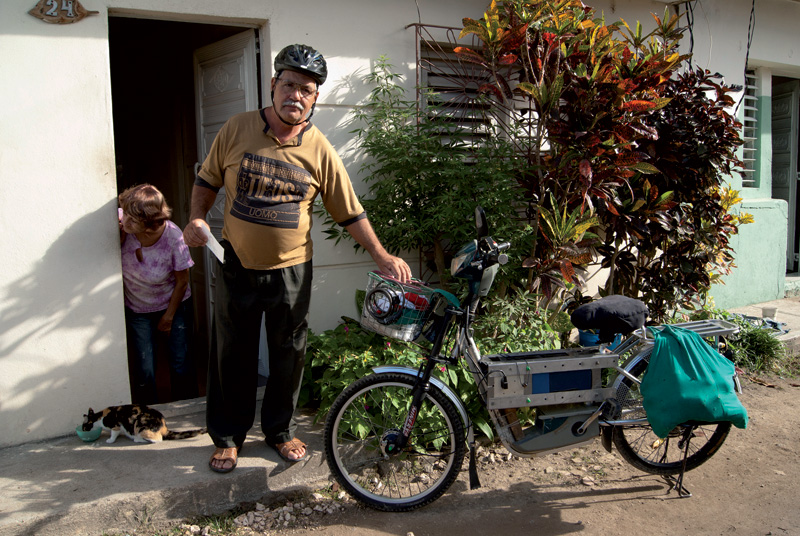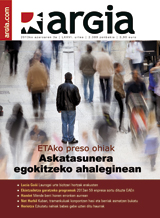Society
Environment
Politics
Economy
Culture
Basque language
Feminism
Education
International
Opinion
saturday 10 may 2025
Automatically translated from Basque, translation may contain errors. More information here. 
Cuban teachers in the technologies of red necessity
- All those who have been in Cuba have told there the curious way citizens have of creating, repairing and keeping alive the instruments they need every day. That is a Caribbean spirit, an imagination excited by the need, a desire to face the economic blockade... Ernesto Oroza has explained this in the 50 years of history of Cuba.

Lezumbalaberenjena erabiltzaileak Flickren laga duen 2012ko argazki honetan, Kubako Santa Clarako senar-emazteak etxe aurrean daukaten rikimbiliarekin. Rikimbili edo riquimbili deitzen zaio beste makina eta ibilgailuenatalez brikolatutako motoari.
‘Do It Yourself’ (DIY) in Basque rather than ‘Do It Yourself’ we would say ‘Only Molda Zaitez’. The formula can well define all the paraphernal solution developed by the Cuban population in its desire to survive in the last half century and which has finally come to form a subculture.
The young Cuban artist Ernesto Oroza, who lives in Miami as on the island, explained on the Motherboard channel in the video “Cuba's DIY Inventions from 30 Years of Isolation”. “Here’s this little storage room I just found,” he says at the beginning. "If it binds to electricity, the clock battery can be reactivated inexpensively. The Sortu use it, because they have to load the stack of the non-stop listening tool.” In the images it can be seen that it is not a commercial product, that is hand flattened.
Objects like this have made Oroza invent the concept of technological disobedience. “They bring a new interpretation of technology, people know so much about technology and engineering that it goes further and further in manipulation, always inventing new things.” Input to technology includes invention, reinvention, reuse, repair...
Anyone who has left Cuba in recent years might think that everything is the result of the terrible period that the island experienced after the disappearance of the Soviet Union, but Oroza has already shown that it came earlier. You have to read it, "Technological Disobedience. Article “From revolution to plastering”.
The revolution brought Fidel Castro to power when he nationalized the companies that the Yankees had in Cuba, the corporations brought with them the majority of Cuban engineers. Appointed Minister of Industry in 1961, Ernesto Che Guevara promoted the slogan of economic recovery: “Worker, you’ve already started building your capacity by building spare parts. Orain, build your own machinery.” The Spare Parts Committees had been organized by the Revolutionary Technicians for a year. Founded in 1963, the National Association of Innovators and Rationalizers. [The reader will forgive us for leaving these nice names and formulas in the original Spanish].
There wasn't much work there. “Broken machines seemed at that time to be the most terrible enemy of the homeland,” Oroza wrote. “The holes generated by the damaged parts of the machines paralyzed the gear of the revolution. The workers began to fill these gaps and, thanks to so many years of work, many of these machines today have more pieces than the ones created by the workers.” If the Yankee engineers who created these machines had gone to Cuba, they would not have been able to know them, but they would have to confess that with their warmer and noisy parts they were as fruitful as before.
Never throw away the old man
Starting in 1960, the technician trying to keep the tools of the atelier alive began to meet the needs of the house in the same spirit, with very few resources. He joined the US embargo, says Oroza, and many others would ratify the lack of effectiveness of the bureaucracy that the new socialism had built.
When Cuba plunged into the crisis in 1970, the workers who had tried so hard realized that they had not managed to fix their families’ day-to-day lives. That is when, according to Oroza, such a topical accumulation occurs in Cuba: “informatics”. In every corner of the house, objects and disorders of all kinds accumulate, as industrial processes do not fix the way of life to adapt them by means of labor.
“You have to solve, mate.” If the fan has been damaged, the piece of one of the thousand gadgets received could serve to repair it. The canning pot you don't have to throw it away, maybe one day make the toy to your grandson.
In the 1980s, thanks to the market organized around the Soviet Union, Cubans have known the equipment they have brought from Europe, all the same: refrigerators of the brand Minsk, televisions or Caribbean or Krim, Orbita fan, washing machine Aurika... The communist industry fostered that rationality, it can also be called monotony. For this reason, very similar products and parts have been preserved in most Cuban houses. This will explain that when the antennas needed to watch later on television are missing, the aluminium trays are seen in as many places as the zarza antennas, always the same...
Obedience was a sign of disobedience to the system. As the socialist camp sank in 1990, Cubans would once again demonstrate the importance of having so many old upheavals at home, “just in case”. The authorities decided that it would henceforth be a “Special Peace Period” and in 1993 extended the first touch within the legislation to citizens who wanted to work on their own.
The Cuban imagination has made a great leap in the Special Article. If the aim of the first moment was to repair the deteriorated ones, more and more new products and services will be completed with parts of the undesigned upheavals. “The cube does not frighten the authorities that have Sony, Swatch or NASA itself.”
By so much undo and rebuild, the Cuban citizen does not see an object in its entirety and image, but as a sum of ingredients that he can use in any emergency. If the base of the fan has been broken, you remember that the phone you were brought from Communist Germany had the same shape and kept it in that corner.
The more serious the crisis is, the stronger the imagination of the citizens has been. For everything they have found spare parts, for transportation, toys, food, clothing... The Army itself helped the citizens in that effort, made public The Family Book bringing together the techniques that people had made known to the Army as the previous books.
Although Raul Castro has launched to open up the economy and has started to introduce many products from abroad, especially from China, Cubans have retained their DIY spirit. The authorities have sometimes tried to hinder products created by citizens in a non-standard way, such as vehicles, among others. But they have had to soften the legislation. For example, for a car to circulate legally it is enough for 60% of its components to be natural: the streets are full of forty by scientists. In the systemic crisis that has brought us the twenty-first century, in Cuba there are models of survival.
Most read
Using Matomo
#1
Lurraren Defentsan Euskal Herria Bizirik
#2
Iban Ayesa
|
Eñaut Iturbe
#3
#4
#5
Xabier Letona Biteri
You are interested in the channel: Kuba
2024-08-20
Urko Apaolaza Avila
Decolonial Itineraries (III)
Vitoria-Gasteiz: Sugar palaces and bitter stories
The epic is built on the lives of many men and knowing that makes society more mature.” The writer Bibiana Candia is right. In Azucre (Pepitas de Calabaza, 2021) we are told the tragedy of the enslaved Galician migrants of the 19th century, but that story would have been... [+]
2024-05-15
Estitxu Eizagirre
What to study of the Cuban agroecological system (inevitably)?
Amets Ladislao has recently been in Cuba knowing his crop model and food system. With the fall of the Soviet Union (USSR) and the worldwide blockade it is suffering, the island of the Caribbean ran out of pesticides and chemical fertilizers, and as a result of these chemicals, a... [+]
2023-11-03
Mattin Azpiroz Pagola
187 countries were in favour of ending the Cuban blockade and only two against: Israel and the US
The United Nations General Assembly adopts the resolution EE.UU. ends the blockade of Cuba, with 187 votes in favour, two votes against (USA and Israel) and one abstention (Ukraine).
2023-01-25
Zigor Olabarria Oleaga
Kubak 17 urtez Pentagonoan infiltratu zuen espioia aske, 20 urte espetxean egin ostean
AEBetako Defentsarako Inteligentzia Agentzian analista lana egiten zuen, eta hainbat informazio sekretu helarazi zizkion Kubako Gobernuari 1984tik aurrera. 2001ean atzeman zuen FBIk, eta 25 urteko espetxe zigorra ezarri zion. Bere aurkako 2002ko epaiketan egin bezala, orain... [+]
2022-12-27
Miel Anjel Elustondo
Emilio Aranguren. Cuban bishop with Basque DNA
"When the revolution was declared atheist, then the change in our house."
This could be the second part of an interview in Havana. On 19 June 2011 we spoke on the ARGIA pages with the bishop of Holguin (Cuba). During the coup d'état of Franco, the mayor of Legazpi, Daniel Aranguren, is the son of Emilia Etxeberria, a direct witness to the exile of his... [+]
2022-11-22
ARGIA
Death of singer Pablo Milanés
Cuban singer Pablo Milanés died at age 79. He has spent his last years in Madrid, but he has offered concerts there and here until the last moment.
2022-10-06
Jakoba Errekondo
Biscayan rum
It's a giant herb that can last for five or six meters. The thick and powerful stem that holds the grass has a flexible, difficult and robust cane structure. It is a sugar cane (Saccharum officinarum). In the subsoil, it forms a hard network of cane roots that support, standing,... [+]
2022-09-27
ARGIA
The new Family Code, approved by Cuban citizens, recognizes same-sex marriage and surrogate pregnancy.
The inhabitants of Cuba have been in favour of the new Family Code, which until now was in force in 1975. Marriages of the same sexes are allowed and the possibility of adopting them, regulates surrogate pregnancy and prohibits the marriage of those under 18 years of age. It was... [+]
2022-09-15
ARGIA
Three political deportees return to Basque Country from Cape Verde and Cuba
The Etxerat association has announced that this summer Emilio Martínez de Marigorta and Felix Manzanos have returned home from Cape Verde and Iñaki Rodríguez Kuba. But there are still five other deportees and 24 political exiles outside Euskal Herria.
2022-08-30
Mikel Garcia Idiakez
Put flowers in the ear, a little more for the masculinity of some men
The experiment is to propose to the men who have been found on the street to photograph the ear adorned with flowers. It is nothing of the other world, and yet it has felt insulted more than one man, so weak is the masculinity of some.
2022-07-28
Maddi Viana Zubimendi
An extreme right man threatens to burn the premises of the Euskadi-Cuba association
The NGO denounces that this is the second time that the same man is opposed to them. This time he tells them that he will burn the premises and that they are "dirty communists" and "marichitos."
2022-05-26
Urko Apaolaza Avila
How did the “modern” bourgeois of San Sebastian make money?
In the Koldo Mitxelena Kulturunea you can see a large exhibition with photographs taken by members of one of the most prestigious families in San Sebastián: They call him advancing. Composed of dozens of photographs taken by José Brunet Berbirmingham in the last third of the... [+]
Eguneraketa berriak daude
























